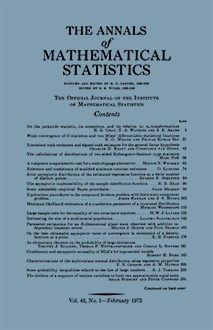Abstract
Most of the nonparametric tests available in the literature use the assumption that the distributions concerned are absolutely continuous. Under this assumption the power efficiencies of these tests for parametric families of distribution are relatively well known. A problem arises, however, when we assume that the distributions are discrete. One would then need to solve the problem of ties, which occur with positive probabilities. One way of getting round this difficulty would be to randomize the order of the tied observations and employ randomized tests. Putter (1955) has presented some interesting results comparing the relative efficiencies of these randomized tests with suitably modified non-randomized tests, when the distributions are discrete. One particular aspect of the nonparametric test, however, has to the best of the author's knowledge, not been discussed so far. This concerns the efficiency of non-parametric tests when the distributions are discrete relative to the most powerful tests available for such distributions when the latter belong to parametric families. One has the impression that the relative efficiencies for such situations are indirectly related to the degree of "discreteness" of the distributions. In other words, the fewer the number of points of probability concentration, the higher is the efficiency. To determine how far this conjecture agrees with the facts, we have discussed the special case of the two-sample Wilcoxon or Mann-Whitney test (Mann and Whitney (1947)). The power efficiency of this test has been worked out for the class of discrete distributions which are of the exponential type, and finally three examples have been discussed.
Citation
K. C. Chanda. "On the Efficiency of Two-sample Mann-Whitney Test for Discrete Populations." Ann. Math. Statist. 34 (2) 612 - 617, June, 1963. https://doi.org/10.1214/aoms/1177704173
Information





